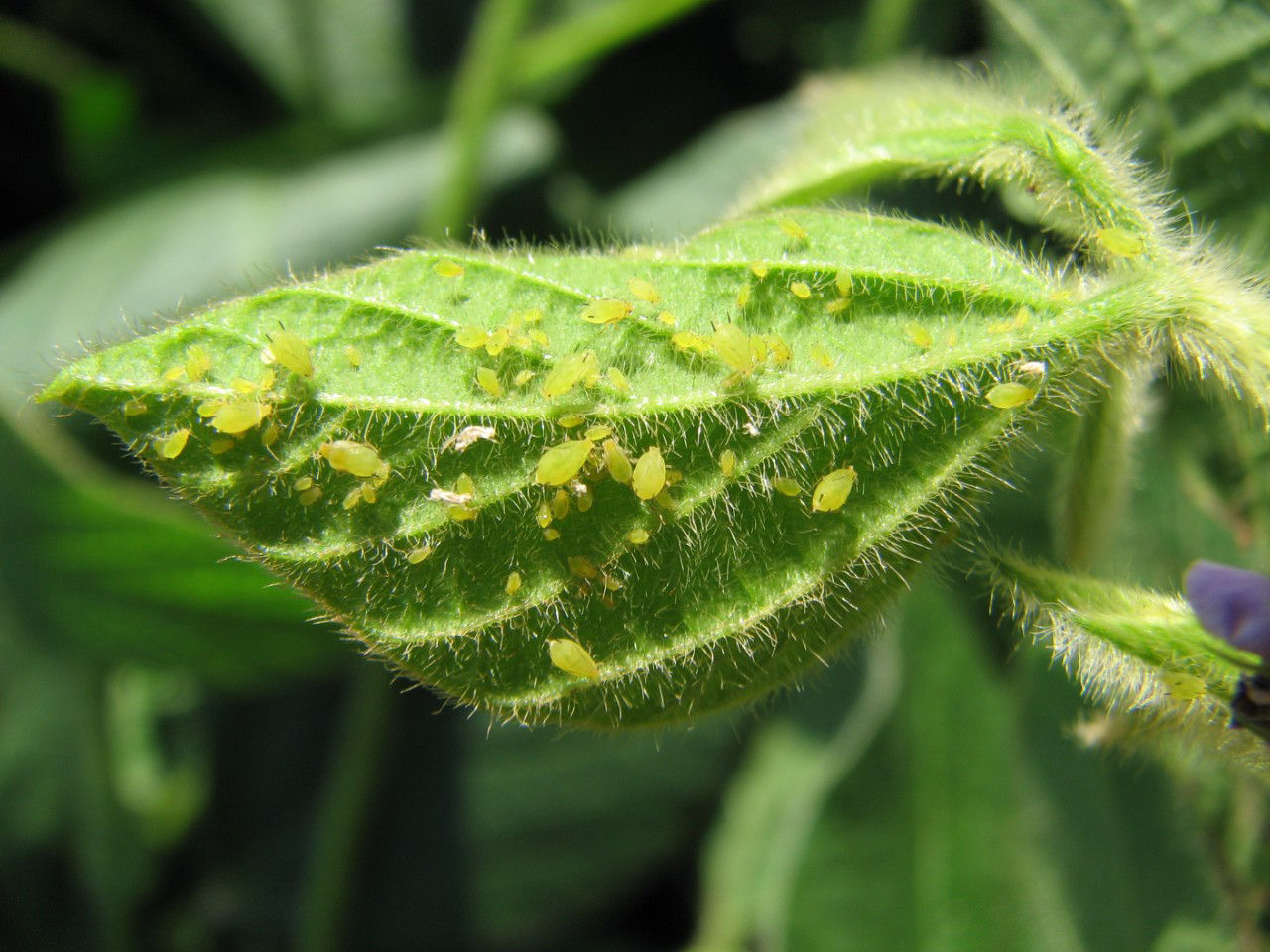4 READ-TIME
Soybean aphid management
July 8, 2021
Soybean aphids are a potential pest to soybeans grown in Canada. When left untreated, soybean aphids can infest plants in high numbers and damage an entire soybean field leaving behind stunted, curled plants. Routine scouting is necessary to estimate aphid populations and to determine if insecticide applications are necessary.
Aphid Biology and Life Cycle
Soybean aphid is native to China and southeast Asia. The pest was first detected in Canada in 2001 on soybeans grown in Ontario and Manitoba.1,2 Soybean aphid populations are erratic and do not occur every year. It is thought that they do not overwinter in many areas of Canada due to cold temperatures and the lack of buckthorn host species, and mainly migrate from the United States. There are areas in Eastern Ontario where soybean aphids come directly from their overwintering buckthorn locations.
Soybean aphids are small, soft-bodied, pear-shaped insects (Figure 1). They vary in color from yellow to green and have black cornicles (tailpipes) on the back of their abdomen. There are both winged and wingless forms, and they feed through piercing-sucking mouthparts.
Soybean aphids migrate during the fall to buckthorn, a small woody tree, which is their overwintering host. They lay eggs on buckthorn from which wingless females hatch in the spring. These females reproduce asexually, and the young develop into winged females that migrate to soybeans. Up to 18 generations of aphids may develop on soybean plants during the year, with the potential to double their populations within a few days under the right conditions. Aphids prefer nice summer weather that is not very hot. Naturally occurring enemies, such as parasites and pathogens, can help keep aphid numbers down if conditions are favorable. Winged aphids may develop during any generation on soybeans and can easily travel or be carried by wind to infest other areas. In late summer, wingless females produce young adults that develop into both winged females and males. In the fall, these winged aphids migrate back to buckthorn where they reproduce sexually. The mated females lay eggs to overwinter and the cycle begins all over again.
Damage to Soybean
Aphids may be small, but they can multiply in large numbers during the year and their feeding can cause severe damage to soybeans. They feed by using their sucking mouthparts and can cause leaves to turn yellow and wilt. They also transmit viruses such as soybean mosaic virus. Additionally, soybean leaves can turn black from sooty mould that can grow on the sticky “honeydew” secretion by aphids. During the early reproductive stages (R1-R2), damage related to flower and pod establishment can lead to yield loss. As infestations carry from pod fill (R3) and beyond, seed size and quality are often reduced.

Figure 1. Soybean aphid feeding.
Scouting and Thresholds
Scouting for soybean aphids should begin early to monitor populations. Begin scouting more intensively during the late vegetative stages and continue regularly at least once every week when soybeans are in the R1 through R5 growth stages. The presence of lady beetles (beneficial insects that feed on aphids) and ants (feed on the honeydew) on soybean often indicates that there is an aphid infestation. Look for aphids on the underside of new leaves early in the season. Aphids will move further down into the soybean canopy as the season progresses. Populations of aphids can increase quickly to damaging levels when soybeans are growing under drought stress conditions. Determine the average number of aphids per plant on 20 to 30 plants throughout the field. Edges of fields can be hotspots for aphid infestations, resulting in overestimation of populations, so make sure to scout all areas of the field. Action is warranted when levels reach 250 aphids per plant with increasing populations on 80% of plants during the R1 through the R5 soybean growth stages.1 This action threshold (AT) provides about a seven-day lead time before aphid populations are expected to exceed economic injury levels. Consider checking fields that reach the threshold three to four days later to determine if aphid numbers are decreasing or staying just below the AT. Treatment may be delayed or not necessary if aphid populations are declining because of natural enemies or weather. Aphid Advisor is an app (www.aphidapp.com) that can be used to incorporate natural enemies into management decisions for soybean aphids.1,2
Management
Several foliar-applied insecticide products are available for aphid control in soybeans. Applications should be saved until aphid populations appear to increase, as beneficial insects may prevent the population from increasing to the economic threshold level. Soybean aphids that are resistant to insecticides are also showing up in Canada, making it important to only spray when necessary to prevent the further development of resistance or to slow the process.4
Sources
1 OMAFRA Publication 811. Agronomy Guide for Field Crops. www.omafra.gov.on.ca.
2 Gavloski, J. 2018. Soybean aphids: identification, scouting and management. Manitoba Pulse Soybean Growers. www.manitobapulse.ca.
3 Gavloski, J. 2018. Soybean aphids: sampling, thresholds and management. Manitoba Agriculture. https://www.gov.mb.ca/agriculture/crops/insects/soybean-aphids.html.
4 Arnason, R. 2019. Soybean aphids fight back. The Western Producer. https://www.producer.com.
Legal Statements
ALWAYS READ AND FOLLOW PESTICIDE LABEL DIRECTIONS. Performance may vary from location to location and from year to year, as local growing, soil and weather conditions may vary. Growers should evaluate data from multiple locations and years whenever possible and should consider the impacts of these conditions on the grower’s fields.
Bayer and Bayer Cross are registered trademarks of Bayer Group. Used under license. All other trademarks are the property of their respective owners. ©2021 Bayer Group. All rights reserved. 5008_S2_CA
